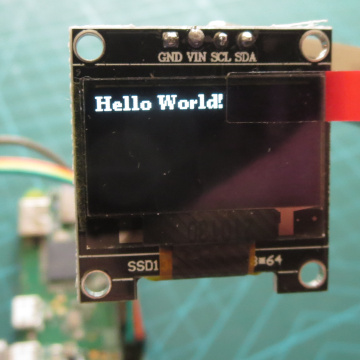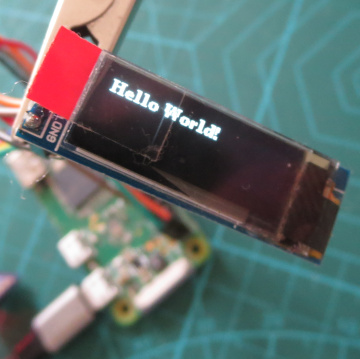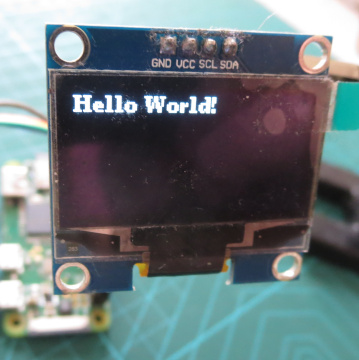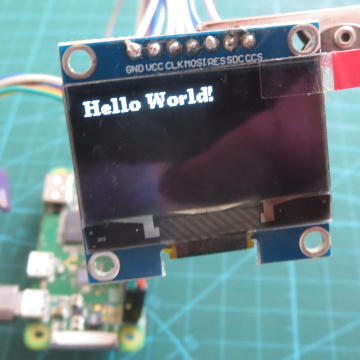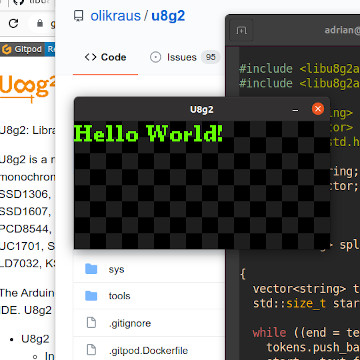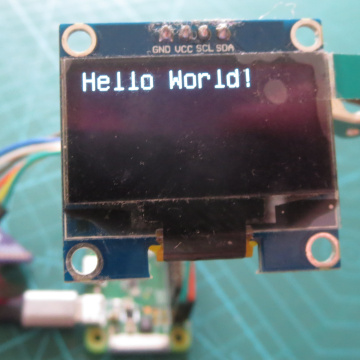The libu8g2arm package makes the U8g2: Library for monochrome displays available for building and installing on Linux-based OSs running on the Raspberry Pi.
It includes source code from U8g2 and the u8g2-arm-linux port.
libu8g2arm is a new package, and likely to contain bugs.
The package is generated by a script, which makes several changes to the base U8g2 code, and specifies how the code will be built.
Any bugs found when using libu8g2arm should be reported to the libu8g2arm project (rather than to the U8g2 project). I will review any issues that relates to packaging, but the help I can provide for other kinds of issues will be limited (I am a casual U8g2 user with only a couple of screens for testing).
See Examples.
The package is built with the Autotools. Create the configure file by running
./bootstrap
Then, build and install in the usual way.
System-wide install
./configure
make
sudo make install-strip
Local install
./configure --prefix="/home/myname/some/dir"
make
make install-strip
Cross-compile
Make a arm-unknown-linux-gnueabi toolchain with crosstool-NG, then
./configure --host=arm-unknown-linux-gnueabi --prefix="/home/myname/some/dir"
make
make install-strip
A display can set up as detailed by the U8g2 project, with some minor differences. A C++ method is also provided for specifying the display at runtime.
Example program ex_init_c.c.
Include
#include <libu8g2arm/u8g2.h>
#include <libu8g2arm/u8g2arm.h>
Follow the instructions for U8g2 C setup.
The gpio callback is u8x8_arm_linux_gpio_and_delay and may be used with the
following byte routines (not all tested)
u8x8_byte_arm_linux_hw_i2cu8x8_byte_sw_i2cu8x8_byte_arm_linux_hw_spiu8x8_byte_4wire_sw_spiu8x8_byte_3wire_sw_spiu8x8_byte_8bit_8080mode
When using hardware I2C or SPI routines, ensure that the corresponding linux
device is enabled (e.g. /boot/config.txt contains dtparam=i2c_arm=on or
dtparam=spi=on). In the program, after calling the display setup function,
register the device parameters
- hardware I2C must call
u8g2arm_arm_init_hw_i2c(u8x8, bus_number) - hardware SPI must call
u8g2arm_arm_init_hw_spi(u8x8, bus_number, cs_number)
Example program ex_init_class.cpp.
Include
#include <libu8g2arm/u8g2arm.h>
#include <libu8g2arm/U8g2lib.h>
Follow the instructions for U8g2 C++ setup
Only the setup classes ending in _F are included in the library.
When using hardware I2C or SPI routines, ensure that the corresponding linux
device is enabled (e.g. /boot/config.txt contains dtparam=i2c_arm=on or
dtparam=spi=on). In the program, after calling the display setup function,
register the device parameters
- hardware I2C must call
u8g2arm_arm_init_hw_i2c(u8x8, bus_number) - hardware SPI must call
u8g2arm_arm_init_hw_spi(u8x8, bus_number, cs_number)
The U8g2 initialisation class constructors for hardware SPI include a CS argument. This argument is unused (the passed value is ignored), but has been retained for compatibility. The CS GPIO number is instead determined by the choice of SPI bus and CS numbers.
Example program ex_init_runtime.cpp.
Include
#include <libu8g2arm/U8g2Controller.h>
#include <libu8g2arm/U8g2lib.h>
The header U8g2Controller.h is fully documented and contains all the controller and parameter settings.
To link to the U8g2arm library, which contains contains only permissive
license code and fonts, link to libu8g2arm (licence: COPYING_permissive).
To use GPL and other copyleft fonts, additionally include
libu8g2arm/u8g2_fonts_gplcopyleft.h and link to libu8g2fonts_gplcopyleft
(additional licence: COPYING_gplcopyleft), and note that this library is
covered by the GPL and not the LGPL. To use noncommercial fonts, additionally
include libu8g2arm/u8g2_fonts_noncommercial.h and link to
libu8g2fonts_noncommercial (additional licence: COPYING_noncommercial).
An extra font, u8g2_font_unifont_world, is included with the copyleft fonts
and includes unifont glyphs for many of the world's languages.
The software I2C and SPI drivers may be unacceptably slow. I recommend connecting the device to work with a /dev/i2c-X or /dev/spidevX.Y linux device, and then use the hardware driver instead.
The package includes all the components used to generate it, which can be used to synchronise with the latest U8g2 code.
Regenerating the package is not required for normal use, and the regeneration process may need to be updated to account for changes to U8g2. For example, the regeneration script may fail, or some replacement files in setup/files may need to be updated manually if the original files change.
WARNING: regenerating the package will delete the src directory before recreating it, and any local changes made under the src directory will be lost.
To regenerate the package, clone U8g2 into a directory parallel to the libug2arm directory, then run setup_src.sh from the libu8g2arm top level directory.
The U8g2: Library for monochrome displays is developed by Olikraus
The U8g2 Arm Linux Port is developed by
- Author: Wu Han
- Homepage: http://wuhanstudio.cc
- Email: wuhanstudio@hust.edu.cn
